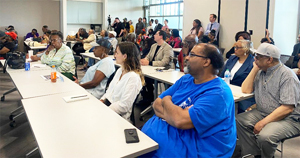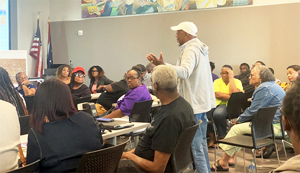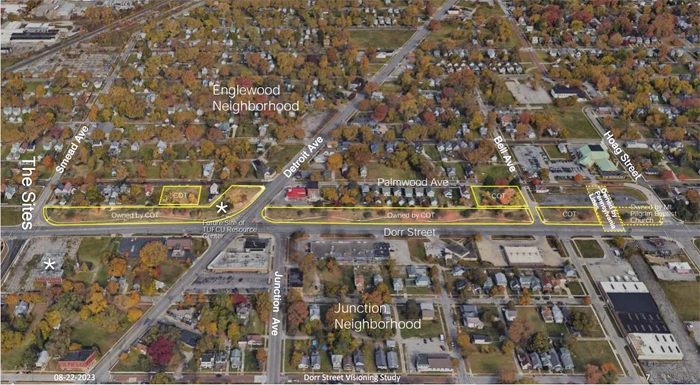
By Dawn Scotland
The Truth Reporter
The Collaborative, an architecture, design and planning firm, in partnership with the City of Toledo, held a Community Visioning Session for the Dorr Street Corridor at Mott Branch Library Tuesday, August 22. The project was commissioned by the City of Toledo as a part of a $25,000 grant awarded to the city by General Motors.
On Tuesday afternoon about 100 community members, officials and business owners attended the presentation and visioning session for the historic Dorr Street corridor.
General Motors awarded the City of Toledo a GM on Main Street Grant of $25,000 “to fund a site-specific visioning effort for the series of City-owned parcels along Dorr Street, between Hoag Street and Smead Avenue.” Historically, the Dorr Street corridor was the hub of hundreds of Black-owned businesses and residential housing that were razed due to urban renewal policies of the 1970s.

“The goal of this project is to explore potential redevelopment opportunities and generate recommendations that support ongoing community efforts to re-activate this once thriving commercial corridor,” said Rachel Momenee, senior planner of the Collaborative.
The Collaborative “is an architecture, design and planning firm with offices in Toledo and Ann Arbor.” The group’s past projects include the new Glass City Center downtown, the Key Bank Theatre at Imagination Station, and the Huntington Center among others. (source: tc.design).
Key members of the community gave remarks preceding the presentation including Councilwoman At-Large Cerssandra McPherson; Suzzette Cowell, president and CEO of the Toledo Urban Federal Credit Union; Pastor Willie Perryman of the Jerusalem Baptist Church and president of the NAACP and Robert Smith, CEO and founder of the African American Legacy Project. The leaders spoke of history of the once bustilng corridor and ongoing efforts to improve Dorr St. including the TUFCU’s new resource center that will be located on Dorr, Detroit and Palmwood.
Momenee outlined the historic and current uses of the city owned and currently vacant parcels along the section of Smead to Hoag on Dorr St. and provided the Collaborative’s ideas:
- Enhance Dorr Street to improve pedestrian experience
- Add a planted median
- Reduce Travel Lane widths to slow traffic
- Include 10’ Multipurpose path connecting Englewood & Junction neighborhoods to Downtown
- On -street parking and Flexible Tree Lawn / Planted Are
-

Community member Robert Gorree, among others present, pose questions and concerns Redevelop sites to make more urban and mixed-use
- Target Commercial Mixed -Use Zoning and Pedestrian Overlay District
- Develop a building street wall 0’ setback
- Add Public/Private Zone with seating
- Develop a mix of uses including residential
- Respect existing single -family uses
- Setback future development from the alley as a buffer
- Create intentional pocket parks and connections into neighborhood
- Activate in the near term with pop -up uses and programming
- Create intentional areas for gathering and programming
- Consider pre -fabricated structures like shipping containers or sheds for commercial use
- Reflect the Dorr Street Corridor History and Culture
- Support on-going community planning and efforts to re -activate the corridor.
- Include uses that represent the communities needs and desires
- Include public art & references to historic uses
The Collaboratives also showed various examples of these developments in places like Chicago, IL; San Jose, CA and Seattle, WA. Including modified shipping container marketplace in place of brick and motors stores to provide low-cost options for businesses in Portland, OR.
Many community members voiced their discontent and concern, voicing that they wanted an opportunity for input prior to the recommendations provided by the firm. Others addressed the mistrust in the community due to the results of previous government planning including urban renewal and the concern of being removed and displaced due to new redevelopment.
Several attendees addressed the need for and questioned the opportunity for ownership in future development. “What happens to the families, the single family homes, where is the ownership?, said 70 year+ resident Doris Greer. “Who owns these pre-fab partial buildings?… we’re talking about Dorr St. that had ownership of brick and mortar or we ran a business out of brick and mortars… is the city going to offer some of this land to be owned by the people in this room?”
Others commented that there was a lack of community input and an oversight of cultural needs and desires in the project. “These need to come somewhere in the beginning of your thinking…” expressed Greer. Many agreed.
The Collaborative ensured that this is “a small part of the on-going community effort to envision the revitalization of the Dorr Street Corridor.” They relayed along with the representatives present from the City of Toledo that the findings can be used in conjunction with other projects regarding the revitalization of Dorr Street and serve as a touch point in conversations to generate future investment and development in the area.
The firm’s presentation ended with the group asking community members to engage in an exercise to express their feedback, concerns and suggestions about the Dorr St. Corridor on boards with post-it notes.

